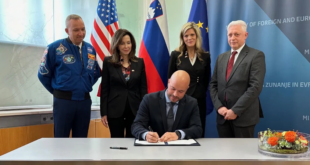
By Dr. John B. Sheldon
U.S. Vice President Mike Pence gave a remarkable “Kennedy” style speech on 26 March 2019 in Huntsville, Alabama, where he stated that the United States will put Americans on the Moon again – in as soon as five years. China demonstrated, with Chang’e 4, their capability to land on the far side of the Moon. Israeli NGO SpaceIL’s Beresheet spacecraft, though ultimately unsuccessful in its soft landing, did reach the Moon’s surface on 11 April 2019. This has all happened without Europe. SpaceWatch.Global Chairman, Dr. John B. Sheldon, shares his thoughts on Europe’s ability to carry out Moonshots in the 21st century.
When U.S. Vice President Mike Pence spoke at the Fifth Meeting of the National Space Council in Huntsville, Alabama, on 26 March 2019, he praised U.S. leadership and dominance in space – see the speech here. This year, we will celebrate the 50th anniversary of humankind, in this case, Americans, landing and walking on the Moon.
With the end of the Apollo programme, the interest in our nearest neighbour was soon extinguished.

Now, some 50 years later, the international community is engaged in a new race to the Moon. This time, new actors are entering the scene. New superpowers like China have entered the race, demonstrating the ability to land for the first time on the far side of the Moon. India is preparing Chandrayaan-2, its second mission to the Moon.
The commercial market is also experiencing an awakening. NASA has selected nine commercial companies to enter the NASA services catalogue. The budget of the Commercial Lunar Payload Services (CLPS) programme amounts to U.S.$2.6 billion over ten years. A significant number of participants of the Google Lunar XPRIZE, or their international successor companies, are from the United States, India, and Israel and are pushing private business towards the Moon.
And what about Europe? Europe seems to be busy with dealing with its own continental issues. Not to mention Brexit, there is also China’s interest in market access to Europe via their Belt and Road Initiative (BRI) such as Italian ports, German 5G frequencies, and more.

The European Union’s commissioner in charge of European space activities, Elżbieta Bieńkowska, recently highlighted European success in space with Galileo, Copernicus, and GovSat. Furthermore, a European Space Force has been hinted at, and all this in anticipation of the European elections in May 2019.
Just a few years ago, European Space Agency’s (ESA) Director Jan Woerner sparked an international conversation about the concept of a Moon Village – at a time when the global focus was on Earth orbit and on Mars, but not on the Moon. That was a bold move for a new initiative.
This year will be one of the most important for ESA and the future of independent European space activities. Global co-operation – one of the Sustainable Development Goals promoted by the United Nations – is very important, but cooperation will only be valuable if all parties will have equal rights.
In the Autumn of 2019, the European space ministers of the ESA Council will meet at #Space19 to discuss, negotiate, and confirm budgets for Europe’s most prestigious and most important space programmes. These will include programmes for independent access to space with the new Ariane 6 space launch vehicle; for returning to the Moon (or “forward to the Moon“ according to Jan Woerner), such as Heracles or the In-Situ Resources Utilization – Demonstrator Programme (ISRU-DM). Also seeking European space ministers approval are the continuity and extension of European participation in the International Space Station (ISS) and European participation in NASA’s (Lunar) Gateway programme.

Credit: ESA–K. Oldenburg
One of Europe‘s first projects to foster private and commercial lunar activities is ISRU-DM. With around 250 million Euro budgeted, it sadly demonstrates the paltry commitment of Europe to the Moon, especially when compared with the U.S.$2.6 billion NASA will spend on CLPS.
ISRU-DM is small compared to the other projects that are on the table for discussion, but this project has a unique value for Europe‘s private New Space industry. If ISRU-DM does not happen, then European science experiments have no option other than to fly their payloads on a commercial U.S. lander, or on national Chinese and Indian landers in the future.
It is not acceptable that European tax payer money flows to non-European companies. With ISRU-DM the European Space Agency has a chance to spark European commercial lunar activities and to start a New Space ecosystem on the continent. European and national government support for European innovation and entrepreneurship has to happen, otherwise the race to the Moon is lost for Europeans before it has even begun. Europe has to find a way to develop its own strengths and make its own Moonshots.
Luxembourg has been at the forefront of the creation of legal frameworks and financial support for private space companies aiming for the Moon, yet the European investment community is timid when compared their U.S. and Chinese counterparts. At the same time, Europe is flooded by Chinese money looking to buy up European technology and Intellectual Property that will be repurposed to help China compete with the U.S. in the emerging space economy. The geopolitical interest of this money has a clear direction and it excludes investors from the lucrative U.S. market.
So I raise the question: what is Europe doing for its own space ecosystem and market? Will there be a European presence on the Moon in the next decade or will Europe be a minor division player in other international programmes?
Dr. John B. Sheldon is the Chairman and President of ThorGroup GmbH, and the publisher of SpaceWatch.Global.





